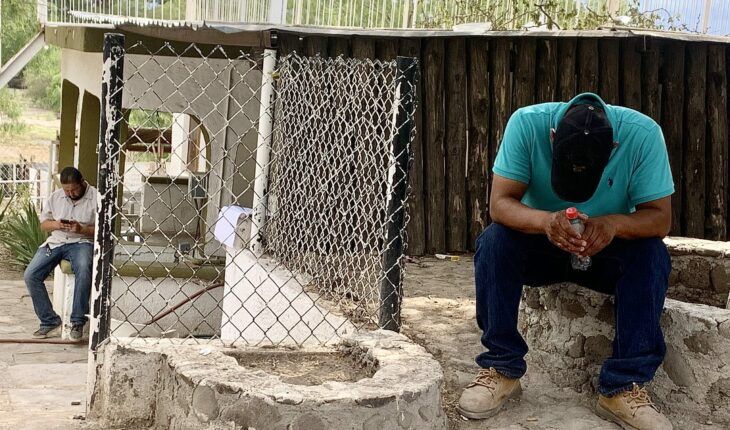Sitting in a circle on plastic chairs and around candles, five women pray in a low, monotonous, almost imperceptible voice.
“Santa María, madre de Dios, we beg you, ma’am, listen to us…”, they ask in unison, while the orange flames of the candles flicker next to a figure of the Virgin of Guadalupe and the photograph of one of the 10 miners trapped in the coal pit of El Pinabete, in the municipality of Sabinas, north of Coahuila.
Since this Wednesday marked one week of the accident in which the mine was flooded with water, the mood among the relatives has been declining with every hour without news of their loved ones. “We still trust in the miracle,” say some of the women who accompany the prayers in a leaden, exhausted silence. But the truth is that, nine days after the accident, more than 200 hours later, maintaining hope has become increasingly difficult, even for the most believers, who on Thursday night made a walk with candles to reaffirm their faith in that miracle.
Cecilia Cruz is one of the people who have begun to mentally prepare for what may happen. He still repeats like a mantra that “I hope and God wants” that the miners are still alive, but he sees it increasingly difficult for his nephew Sergio Gabriel Cruz Gaytán, 41, to walk out of the well in which he disappeared after a rumble was heard under the ground.
“We only know what they say to my brother in there,” says Cecilia shrugging her shoulders, while scaring away flies as sticky as the suffocating heat that hits the Coahuilense land, full of coal in its bowels.
Cecilia thus refers to the other camp, the one on the other side of the restricted area established by the elements of the National Guard and which is closer to the stricken area. There remain the most direct relatives of the trapped miners, although in the other camp, where Cecilia is next to the media that still remain in the place, there are also parents, children and brothers of the miners.
One of them is Mr. Antonio Cabriales, an 81-year-old man who desperately asks to be let down to the well to try to rescue his son, Mario Alberto Cabriales Uresti, 41. Another is Angélica Montelongo, who does not separate herself from the altar that raised St. Jude Thaddeus, the saint of impossible causes, to ask for her brother, Jaime Montelongo Pérez, a 61-year-old veteran miner who, although he was already pensioned, continued to go down to the well in search of coal and a livelihood.
“Every day we hear them say, ‘Now, the water has come down. The divers are going to come in to rescue them.’ But, until now, we do not know if they have already entered or what they are doing,” laments the woman, who bathes her baby in a bucket, given the lack of facilities in the vicinity of the injured coal well.
“A lot of negligence and waste of time”
So far, government authorities have reported that more than 150,000 cubic meters of the water that flooded the mine are extracted and that now runs murky down a path that passes a few meters from the camp of the relatives. And on Friday, federal Civil Protection said during the morning conference of President Andrés Manuel López Obrador that there are already “all the conditions” to descend to the mine to make a new rescue attempt. The president himself has publicly insisted that work is being done day and night to carry out the rescue.
“The president came here to see us (last Sunday, August 7), to give us a few words of hope. He told us to trust, that everything was going to be fine, but the days go by and we see that nothing happens. That’s why we often think the worst,” Cecilia says with a thread of voice.
“There has been a lot of negligence and a lot of waste of time,” says another relative, visibly upset, who says she does not understand why in the morning conferences the national coordinator of Civil Protection, Laura Velázquez, insists that there are already conditions to carry out the rescue and then it does not materialize.
“Why do they tell us that if they don’t comply with it later? Nothing else generates more anguish,” complains the woman.
From Sabinas, Coahuila, @ManuVPC details that, according to Civil Protection, it is expected to have the conditions today for divers to try to rescue the 10 trapped miners. pic.twitter.com/Qumt8NlynB
— Animal Político (@Pajaropolitico) August 12, 2022
At this point – the ninth day, more than 200 hours after the collapse – the ghost of the Pasta de Conchos mine, located just a few kilometers away from El Pinabete and where in 2006 a group of 65 miners was trapped after a fatal explosion, begins to seize the desgAstado mood of the camp. No one here wants to hear that name, but everyone is in their heads about what happened to those men who, 16 years later, are still buried under the coal mine.
“We want them to be handed over to us. Whether they are alive or dead, but let them be delivered,” emphasizes Mrs. Cecilia.
“We don’t want one day to come and say, ‘Well, you better cover it there and there it is.’ Because that’s already happened! The woman exclaims, raising the tone of voice with which she speaks regularly. This happened in Pasta de Conchos. The mine exploded, they all died and were left abandoned. It is our greatest fear,” she says, pointing with her chin at her husband, a man with a leafy mustache and a face cracked by the sun, also a miner. That is why we demand that our authorities hand over our boys to us, whatever it may be, but to hand them over to us.”
What we do at Animal Político requires professional journalists, teamwork, dialogue with readers and something very important: independence. You can help us keep going. Be part of the team.
Subscribe to Animal Político, receive benefits and support free journalism.#YoSoyAnimal





